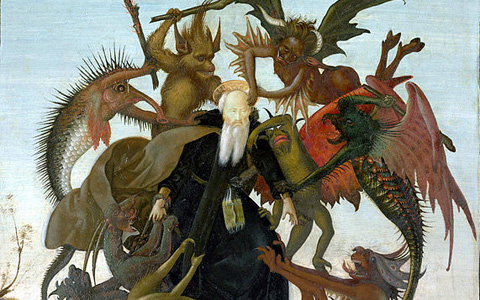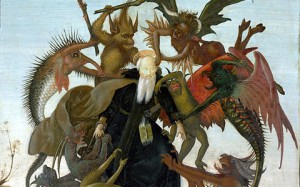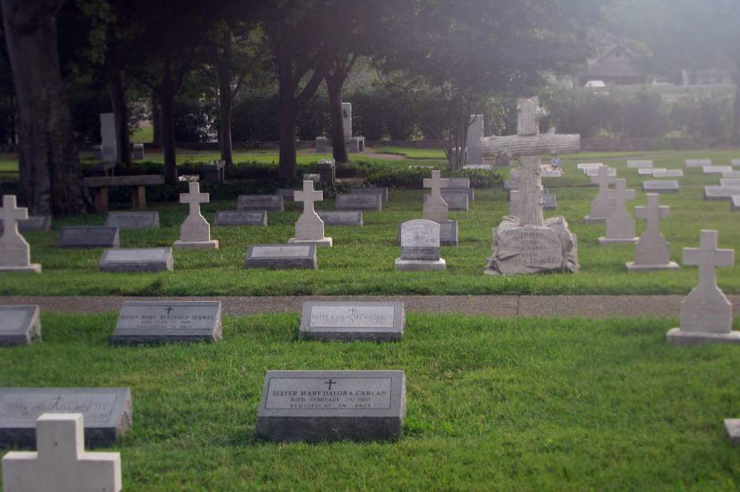St. Athanasius of Alexandria gifted us a beautiful account of a great saint in the Life of Antony. St. Anthony grew up in a good, loving, wealthy and faithful home in Egypt. He was not drawn to learning his letters, but he was a devoted and obedient son who paid close attention by hearing what was read in his home and in the house of God; he kept all that was good in his heart.
When his parents died, he was eighteen and this humble soul took Christ at His word in Mathew 19:21 when He said: “If you wish to be perfect, go, sell your possessions, and give the money to the poor, and you will have treasure in heaven; then come, follow me.” St. Anthony gave away substantial wealth, including 300 acres of good and productive land, and after securing the wellbeing of his little sister, he gave the proceeds from his remaining goods to the poor, and then he followed Christ into the desert.
The Devil detests such goodness in a young soul and early on St. Anthony had to engage in spiritual combat so fierce that it echoes down the halls of time. Satan began by tempting him with whispers drawing on memories of his riches, enticing him to remember the call to glory, pleasures of food, lust and relaxation as contrasted with the labor and discipline required to cultivate the virtues of the ascetic life in the desert. Though the serpent plagued him night and day, St. Anthony’s faithful response was constant prayer and fasting because “his mind was filled with Christ and the nobility inspired by Him.”
St. Anthony practiced such arduous asceticism that he levitated. His piousness soon attracted countless demons who ruthlessly persecuted him as well. Perhaps in the most terrifying account of battle, St. Anthony entered a cave full of demons who beat him so treacherously that his servant found him dead. He was carried home and as his brothers were mourning his death, he miraculously revived. St. Anthony bid his servant to return him to the cave where he had been so mercilessly beaten and there he summoned the devils again. Wild beasts and savage demons appeared and resumed attack by horns, teeth, claws and insults, until there appeared a bright light. The demons fled and St. Anthony knew that Christ had made his presence known. St. Anthony asked our Lord, “O good Jesus, where have you been so long? Why did you not help me in the beginning to heal my wounds?” And Christ answered him “I was here but I would see and abide to see thy battle, and because thou hast manly fought and well maintained thy battle, I shall make thy name to be spread through all the world.” In the universal call to spiritual combat, it is Christ’s desire to see us fight bravely and well as did St. Anthony in the desert.
A striking rendition of St. Anthony’s combat is portrayed by Michelangelo’s earliest known masterpiece: The Torment of St. Anthony. By the grace of God, St. Anthony defeated the Deceiver and the demons. His heroic life stands as a model for all Christians to imitate as we gird our loins and prepare for the spiritual combat. There are no pacifists in the Body of Christ, for we are called to battle Satan, this fallen world and our own flesh now prone to deceive us, as Christ reminds us in Mathew 26:41, “Watch and pray that you may not enter into temptation; the spirit indeed is willing, but the flesh is weak.” It is our conduct and bearing in this combat that determine the eternal disposition of our immortal souls in Heaven or Hell.
The Devil would have us forget the heroic battle of St. Anthony, but Michelangelo and many other fine artists build a bridge to memory through their great religious works. Time fades recollection and we are ever in need of renewed remembrance. There has emerged a warrior from Belgium whose combat bears a resemblance to the Torment of St. Anthony and his witness is a reminder of the spiritual battle that awaits the blessed faithful.
In Brussels on April, 23, 2013, “Archbishop Andre-Joseph Leonard, in an astonishing display of gentleness in the face of a vile attack, remained calmly seated with eyes closed in prayer as four topless women attacked him with shouts and curses and doused him with water…It’s not the first time the bishop has been attacked for standing up for the Church’s teachings on homosexuality.”
As he spoke on these issues, he was attacked by members of a pro-abortion and homosexual group called FEMEN. Just a little more than six months later, October 18th, 2013, the good Archbishop was attacked again by the same legion, but this time they put pie in his face. Just as in the life of St. Anthony, we can expect the severity of these attacks to intensify and their frequency to increase.
To the Glory of God, the good Archbishop battled honorably in a reenactment of the spine-chilling events depicted by Michelangelo’s masterpiece. Megapixels and fiber optics replace the oils on canvas and the story is retold in exacting details without the charm of the master painter’s style, but in the stripped down medium of raw digital footage particular to our age.
The photos that accompany this contemporary retelling of the ancient combat are graphically disturbing. To compare the face of St. Anthony to the good Archbishop’s is to see the peace of soul that accompanies God’s gift of grace to men of good will in the midst of combat. Yet still, we read the Archbishop’s profound sadness at the state of his tormentors and it adds depth to his witness.
The four women in the service of the accuser in the first attack played their roles masterfully. The demonic similarities between the demons in the painting and the gay rights activists in the photos are compelling indeed. The degradation, the rage, the filthy messages, the viciousness all signal the Culture of Death so meticulously crafted by the Prince of Darkness.
Bishop Fulton Sheen once described the three attributes of the demoniac as the love of nudity, violence, and division — a split mind. These are the calling cards the Tempter leaves with all who receive his attentions. A brutal example is depicted in the way the activists attacked the Archbishop. As he prays, the vicious women degrade with nudity, violence and double standards.
In the Sermon on the Mount, Mathew 5:11, Jesus said, “Blessed are you when men revile you and persecute you and utter all kinds of evil against you falsely on my account.” The good Archbishop as a witness for Christ has given us a great lesson in this simulacrum of the Torment of St. Anthony. It is a fulfillment of Christ’s own words that we will be reviled for His sake. The good witness has shown us in vibrant terms the contradiction the Body of Christ faces in this vale of tears. We are living in times of great trial, turmoil, and renewal. The seeds of Christian virtue sown by the Body of Christ in the vineyard of the Lord will be watered with the blood of the martyrs. May God bless and keep the good Archbishop and may Our Lord grant us the courage and strength to fight as unwaveringly as the Saints in the spiritual battle to which we are all called!
Onward Christian Soldiers!
January 17 is the Memorial of St. Anthony, Abbot (A.D. 251 – 356)
If you liked this article, please share it with your friends and family using the Share and Recommend buttons below and via email. We value your comments and encourage you to leave your thoughts below. Thank you! – The Editors















